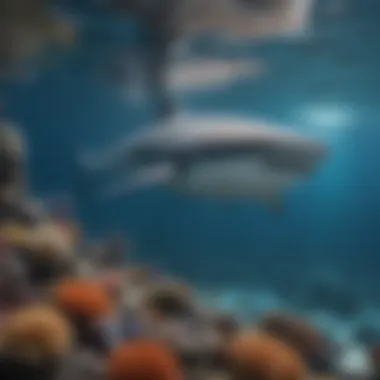Habitat of the Whale Shark: A Comprehensive Exploration


Nature Topic Overview
The whale shark is the largest fish in the ocean. This gentle giant is known for its unique pattern of spots and stripes. Both fascinating and important to marine ecosystems, whale sharks inhabit warm, tropical waters. They are often seen near coasts and in open ocean. Their preferred habitats include coral reefs and oceanic upwellings, where food is plentiful. Understanding the habitat of the whale shark is crucial for their conservation.
Whale sharks thrive in specific environments. These areas provide the right conditions, such as temperature, salinity, and food availability. They primarily feed on plankton, small fish, and other marine life found in welcoming zones. The conditions in these habitats allow them to grow and reproduce. Unfortunately, their habits are under threat from human activities like fishing and pollution.
Conservation efforts seek to protect these important habitats. By preserving whale shark habitats, we ensure these magnificent creatures can continue to roam our oceans. Education plays a vital role in this process. Learning about marine ecosystems and the challenges they face is necessary for young minds.
Fun Facts and Trivia
- Whale sharks can grow up to 40 feet long!
- They can live for about 70 years or more.
- Whale sharks have a filter-feeding system; they swim with their mouths open.
- Each whale shark has a unique pattern of spots, much like a fingerprint.
These facts highlight the uniqueness of whale sharks. They engage young readers and encourage curiosity about the ocean.
Wildlife Explorations
Whale sharks share their habitat with various marine species. Other animals found in these waters include:
- Manta rays: These large rays often swim in the same areas as whale sharks. They are also filter feeders.
- Turtles: Sea turtles, like the green sea turtle, often inhabit similar environments, enjoying the same abundant food sources.
- Coral reefs: These ecosystems support diverse marine life, including smaller fish that attract bigger predators like whale sharks.
Interactive features such as quizzes can help reinforce knowledge about these species and the ecosystems they share.
Environmental Awareness
Conservation is essential for maintaining the habitats of whale sharks. Here are some vital points to consider:
- Human activities, such as fishing and pollution, threaten marine habitats.
- By protecting these environments, we preserve not only whale sharks but the entire marine ecosystem.
- Young readers can learn about small actions to make a big impact, like reducing plastic waste and supporting ocean conservation initiatives.
Teaching children the importance of environmental awareness is vital. It cultivates a sense of responsibility towards nature.
DIY Nature Activities
Activities can enhance understanding and appreciation of whale sharks and their habitats. Here are a few ideas:
- Create a whale shark mural: Children can use colors to paint or draw whale sharks and their environment. This encourages creativity and learning.
- Ocean scavenger hunt: Kids can search for images of marine species, both in books and online. This activity can highlight various organisms in the whale shark habitat.
- Storytelling session: Encourage storytelling about the ocean and its creatures. Children can share what they have learned about whale sharks, helping them retain information.
These hands-on activities foster a lasting connection to marine life and introduce young minds to valuable conservation principles.
Foreword to Whale Sharks
The whale shark is the largest fish species in the world, known for its majestic presence in our oceans. Understanding whale sharks is essential for wildlife enthusiasts and marine biologists alike. This section serves as an entry point into the world of whale sharks, focusing on their defining characteristics and ecological importance. By exploring what makes the whale shark unique, we can better appreciate why their habitat deserves protection.
Defining the Whale Shark
The scientific name of the whale shark is Rhincodon typus. These gentle giants can grow over 40 feet in length and weigh as much as 20 tons. Their distinct spotted skin helps them blend into the ocean environment while they cruise through the water. Whale sharks have a wide mouth that can measure up to 5 feet across. This anatomical feature is crucial for their feeding habits, as they engage in filter feeding to consume plankton, small fishes, and other marine organisms.
Whale sharks have a slow-moving lifestyle. They often swim alone or in small groups, yet they are not territorial. Instead, they roam vast distances in search of food, taking them into diverse habitats. Their behavior and migration habits are still being studied, providing insights into their movement patterns and adaptation to various conditions.
Significance in Marine Ecology
Whale sharks play a vital role in marine ecosystems. As filter feeders, they help maintain the balance of the ocean environment by controlling plankton populations. This ecological role supports the health of coral reefs and other marine habitats. Whales sharks are also an indicator species, meaning their presence reflects the overall health of marine ecosystems. When whale shark populations are thriving, it often indicates that the marine environment is in good condition.
"Whale sharks interact with numerous species, and their existence underscores the interconnectedness of marine life."
Beyond their immediate ecological impact, whale sharks contribute to marine tourism. Places where they are abundant attract divers and snorkelers, promoting conservation efforts in those regions. Sustainable practices developed around whale shark tourism can benefit both local economies and the preservation of these magnificent creatures.
In summary, the section on whale sharks sets the stage for understanding their habitat and how it relates to their survival. Recognizing their defining features and the ecological significance helps foster awareness about the importance of their protection and the preservation of their natural environments.
Natural Habitat of the Whale Shark


The natural habitat of the whale shark is crucial for understanding how these magnificent creatures thrive in marine environments. Whale sharks tend to prefer specific areas that cater to their needs for feeding, breeding, and overall survival. Diverse habitats include coastal regions, the open ocean, and reef systems, all of which offer unique benefits and challenges. Understanding these environments helps to emphasize the importance of conservation efforts.
Preferred Marine Environments
Coastal Areas
Coastal areas are shallow regions close to land, often rich in nutrients. These areas support a variety of marine life, making them attractive feeding grounds for whale sharks. The abundance of plankton, which forms a major part of their diet, can be found in these waters, especially near estuaries where tidal flows mix ocean and freshwater.
- Key characteristic: Nutrient-rich waters are abundant due to runoff and upwelling.
- Contribution to ecology: These areas serve as breeding grounds for many marine species, contributing to a healthy ecosystem.
- Unique feature: Coastal areas can be affected by human activity, such as fishing and tourism. Maintaining a balance between use and conservation is essential.
Open Ocean
The open ocean, or pelagic zones, covers vast areas of water away from the influence of land. Whale sharks are often found in these deep waters, where they can migrate long distances. The open ocean provides ample space for these gentle giants to swim freely.
- Key characteristic: It is characterized by deep waters that are less affected by coastal human activities.
- Contribution to ecology: This environment supports diverse marine organisms and is crucial for the larger food web.
- Unique feature: Although the open ocean provides a habitat with fewer human disruptions, it also poses threats such as ship strikes and plastic pollution.
Reef Systems
Reef systems are underwater structures created by coral formations. These systems are complex and support a high diversity of marine life, providing habitats and feeding grounds for whale sharks. Rich in biodiversity, reefs attract many organisms that serve as food sources for these sharks.
- Key characteristic: High biodiversity and complex ecosystems foster greater food availability.
- Contribution to ecology: Reefs contribute significantly to the health of the ocean, acting as natural barriers and supporting marine life.
- Unique feature: Reef systems face pressures from climate change, which can lead to coral bleaching and reduction in biodiversity.
Geographical Distribution
Tropical and Subtropical Regions
Whale sharks are typically found in warm tropical and subtropical waters. These regions are ideal for their growth and reproductive cycles. The temperature and salinity in these areas are conducive to their biology and behavior.
- Key characteristic: Warm waters promote higher concentrations of plankton.
- Contribution to ecology: The presence of whale sharks in these areas indicates healthy marine ecosystems.
- Unique feature: Seasonal changes bring varying concentrations of food sources, influencing shark behavior and distribution.
Migration Patterns
Migration patterns are crucial for whale sharks as they travel thousands of kilometers in search of food. These movements often coincide with seasonal blooms of plankton, ensuring that the whales can find sufficient sustenance. Understanding these patterns is important for conservation efforts.
- Key characteristic: Migratory behaviors are intimately linked to environmental conditions.
- Contribution to ecology: Migration supports genetic diversity by connecting different populations.
- Unique feature: Migratory challenges include navigating past fishing zones and changes in oceanic conditions that affect food availability.
Understanding the habitats of whale sharks is essential for ensuring their survival. Efforts must focus on sustainable practices that protect these environments.
By recognizing the importance of marine habitats and their peculiar ecosystems, we can better appreciate the role of the whale shark in maintaining the health of our oceans.
Feeding Habits and Ecosystem Role
The feeding habits of whale sharks play a crucial role in their ecosystem, influencing both their survival and the health of marine environments. As the largest fish in the ocean, whale sharks primarily feed on plankton, small fish, and other microscopic organisms. This filtering process not only sustains the whale shark but also affects the population dynamics of the species they consume. Understanding these feeding habits is essential for appreciating the ecological balance within their habitats.
Filter Feeding Mechanism
Whale sharks utilize a filter feeding mechanism that is distinct and efficient. They gulp large amounts of water while swimming with their mouths open. The water enters the mouth and passes through gill rakers, which are specialized structures that trap food particles. This method allows whale sharks to consume enormous volumes of phytoplankton and zooplankton without expending excessive energy.
The efficiency of this feeding adaptation is vital for their energy needs. Whale sharks can filter several thousand liters of water every hour, extracting small nutritional morsels as they navigate the ocean. This feeding behavior demonstrates their role as important grazers that help control plankton populations.
Interactions with Other Species
Interactions with other marine species illustrate the complex relationships within the ocean ecosystem. Two vital aspects to consider are symbiotic relationships and predatory threats.
Symbiotic Relationships
Symbiotic relationships occur when different species benefit from each other. For whale sharks, this often includes small fish and crustaceans that seek refuge in their gills or on their skin. This arrangement provides a safe habitat for the smaller organisms while also keeping the whale sharks clean of parasites and dead skin.
The mutualistic nature of these relationships enhances the overall health of whale sharks. They benefit from reduced parasite loads, which can contribute to better overall health and longevity. In this article, understanding symbiotic relationships highlights the importance of diverse interactions within marine ecosystems, showing that no species exists in isolation.
Predatory Threats


Despite their size, whale sharks face predatory threats from larger marine creatures. The most notable threats are from orca whales and large sharks. These predators can target juvenile whale sharks, impacting population sustainability.
Though whale sharks are relatively safe due to their size, recognizing these predatory threats is crucial. It helps illustrate the vulnerabilities even the largest marine creatures can face. Understanding the implications of predation is essential for developing conservation strategies to protect whale sharks and their habitats.
Understanding the feeding habits and interactions of whale sharks contributes significantly to our ecological awareness and conservation efforts. Marine health depends on understanding these relationships.
Environmental Conditions Impacting Whale Sharks
Understanding the environmental conditions that affect whale sharks is essential for grasping their habitat needs and survival strategies. These gentle giants are sensitive to various factors such as temperature and salinity in their environments. Knowing how these aspects influence whale sharks provides insight into their ecological role and the risks they face in a changing world.
Temperature Preferences
Whale sharks have clear temperature preferences that guide their distribution in oceans around the globe. They generally thrive in warmer waters, typically between 21°C to 30°C (70°F to 86°F). This temperature range is crucial for their metabolism and reproductive activities. When water temperatures dip below this range, whale sharks may become less active and may even leave their feeding grounds.
The warmer water not only supports their active lifestyle but also impacts the availability of their primary food sources, such as plankton and small fish. Higher temperatures tend to promote plankton blooms, creating feast opportunities for these filter feeders.
Here are some points about their temperature preferences:
- Feeding Efficiency: In warmer conditions, whale sharks can more effectively locate and consume food.
- Migration Patterns: Changes in temperature often lead to migration, as these sharks follow warm currents.
- Breeding Habits: Warmer temperatures can also influence breeding, as female whale sharks seek optimal conditions for gestation.
Salinity Tolerance
Salinity is another environmental factor that affects whale sharks. They generally prefer waters with salinity levels typical of open oceans, around 34 to 36 parts per thousand (ppt). However, they show some remarkable adaptability. Whale sharks can also tolerate variations in salinity, found in places where freshwater mixes with ocean water, like coastal estuaries.
Understanding salinity tolerance is important for explaining why whale sharks may be found near shores or in areas with strong river outflows. Having the ability to adapt allows them access to diverse feeding opportunities.
Key insights about their salinity tolerance include:
- Adaptability to Environments: Whale sharks can inhabit diverse marine ecosystems due to their salinity tolerance.
- Feeding Strategies: Changes in salinity may influence prey availability, affecting their feeding locations.
- Impact of Human Activities: Coastal developments and pollution can alter salinity levels, posing risks to their habitats.
Whale sharks can often be found in both tropical and subtropical waters, showcasing their ability to adapt to various environmental conditions.
By understanding the importance of temperature and salinity, we can better appreciate the specific habitats whale sharks require. Protecting these conditions is crucial for maintaining the delicate balance of ocean ecosystems where whale sharks thrive.
Threats to Whale Shark Habitats
The habitats of whale sharks are under increasing threat due to various environmental and human factors. Understanding these threats is important for appreciating the complexities of marine ecosystems. Whale sharks rely on healthy habitats for feeding, breeding, and survival. Thus, identifying threats allows for better conservation strategies aimed at protecting these gentle giants.
Human Activities
Overfishing
Overfishing presents a significant threat to the whale shark population. This practice removes not only the fish that serve as food for sharks but also disrupts the entire marine food web. Overfishing often targets key species such as plankton, which are vital for the whale shark's filter feeding method. The loss of these species limits the availability of food for whale sharks and can lead to their decline.
The nature of overfishing often leads to bycatch, where non-target species are caught inadvertently. This can harm whale sharks if they become entangled in fishing gear. The key characteristic of overfishing is its immediate impacts on fish populations and subsequent effects on predators like whale sharks.
Some of the unique features include the overreliance on certain fisheries that can collapse due to excessive fishing pressure. The disadvantages are evident, as reduced fish populations can lead to malnutrition or starvation for whale sharks, ultimately affecting their reproduction and population stability.
Coastal Development
Coastal development has also emerged as a prominent threat to whale shark habitats. As humans build resorts, ports, and other infrastructures along coastlines, the natural environment is altered. This development often leads to habitat destruction, which directly affects marine life, including whale sharks.
The key characteristic of coastal development is its rapid pace and often unchecked nature. It transforms vital coastal areas into urban landscapes, disrupting the ecosystems that whale sharks rely on for breeding and feeding. A critical aspect of coastal development is the increased sedimentation in waters, which can block sunlight essential for marine plants.
One of the unique features of this threat is how it reshapes the coastal ecosystem over time. The disadvantages are considerable, as loss of habitat can lead to a decrease in food availability and safe spaces for these sharks to thrive.
Pollution
Pollution, particularly marine pollution, significantly affects whale shark habitats. Chemicals, plastics, and other waste enter the ocean and can harm marine life. Whale sharks are filter feeders and can ingest these harmful substances, which could be fatal to them.
The key characteristic of pollution is its pervasive nature, affecting not just water quality but the entire marine ecosystem. It disrupts the balance needed for a healthy environment where whale sharks live and breed. Polluted waters can lead to the decline of plankton and other small organisms that are essential for whale sharks.


This issue also has unique features, such as microplastics entering the food chain, impacting even small fish. The disadvantages of pollution are severe, as contaminants can weaken whale sharks and make them more susceptible to diseases.
Climate Change Effects
Ocean Warming
Ocean warming is becoming a critical issue for whale sharks. Due to climate change, water temperatures in many regions are rising. Whale sharks have specific temperature preferences, and deviations from their optimal range can cause stress and migratory shifts in search of suitable habitats.
A notable characteristic of ocean warming is that it directly affects marine ecosystems. Higher temperatures can lead to coral bleaching, which reduces biodiversity and can eliminate habitats for smaller fish that whale sharks need. The unique feature is that these changes can lead to significant shifts in migration patterns, as whale sharks may travel further to find optimal conditions.
While warmer waters may benefit some species, for whale sharks, the disadvantages outweigh the benefits. Over time, the increase in temperatures can limit their feeding opportunities and suitable reproductive environments.
Acidification
Ocean acidification, a consequence of increased carbon dioxide emissions, poses another challenge for whale sharks. As the oceans absorb CO2, the water's pH levels drop, leading to more acidic conditions. This influences the availability of food sources, particularly shelled organisms that may decrease in number.
The key characteristic of acidification is its slow, yet pervasive impact on marine life. Many marine species, including plankton, struggle to survive in more acidic waters. The unique feature of this issue is that it can drastically alter food webs and ecosystem functions over time.
The disadvantages for whale sharks include diminished food availability and potential changes in their habitat's overall health. Healthy marine environments are essential for their survival, making the need for addressing acidification critical.
Conservation Efforts for Whale Sharks
Conservation efforts for whale sharks are vital not only for the survival of these majestic creatures but also for the health of marine ecosystems as a whole. These gentle giants face numerous threats primarily from human activities and environmental changes. Effective conservation measures can help protect their habitats, promote their populations, and maintain ecological balance. As a unique species, the whale shark is a crucial part of ocean food webs, and efforts to preserve their existence ultimately benefit diverse marine life.
Protected Marine Areas
Protected marine areas play a critical role in the conservation of whale sharks. These zones are specially designated to safeguard marine biodiversity and create safe havens for various species. By restricting human activities like fishing and development, these areas help maintain the natural environment that whale sharks need.
Some benefits of protected marine areas include:
- Safe breeding grounds: These zones provide spaces where whale sharks can reproduce without the risk of human interference.
- Conservation of food sources: Protected areas ensure that the plankton and smaller marine creatures that whale sharks feed on remain abundant.
- Habitat recovery: Restricted areas allow damaged marine ecosystems to recover over time, making them suitable habitats for whale sharks and other marine life.
Whale sharks have been observed frequenting regions like the Galápagos Marine Reserve and the Belize Barrier Reef, indicating the importance of these protections. The more we understand how protected areas impact whale shark behavior, the better we can implement strategies to conserve them.
Sustainable Practices
Sustainable practices are essential for reducing the negative impacts on whale sharks and their habitats. These methods focus on balancing human needs with environmental health. By adopting sustainable fishing practices, marine tourism that does not harm the environment, and responsible coastal development, we can ensure that whale sharks thrive in their natural environments.
Some effective sustainable practices include:
- Regulated fishing: Implementing strict limits on fish catches reduces overfishing, allowing prey for whale sharks to remain plentiful.
- Eco-friendly tourism: Encouraging marine tours that respect whale sharks and their habitats helps promote awareness and provides support for conservation efforts.
- Community involvement: Engaging local communities in conservation efforts encourages sustainable resource use and protects marine ecosystems.
"Each step taken towards sustainable practices contributes to a healthier ocean, securing the future of whale sharks and countless other marine species."
By incorporating sustainable practices into daily life, individuals can indirectly contribute to the conservation of whale sharks and the habitats they depend on. The collective action of communities can lead to significant positive change for these fascinating creatures.
Epilogue
Whale sharks are vital to marine ecosystems. Their habitat must be preserved for their survival and for the health of oceans. This article has explored various aspects of their habitat. Understanding this is crucial for appreciating these remarkable creatures and their roles in the environment.
Importance of Habitat Preservation
Habitat preservation is key to protecting whale sharks and the ecosystems they inhabit. Whale sharks prefer warm, clear waters and need a variety of environments like coastal areas and open oceans to thrive. When we protect these habitats, we help maintain the natural balance of marine life.
- Biodiversity: Healthy habitats support many species, allowing coral reefs and fish populations to flourish. Whale sharks benefit from this diversity, as it forms part of their food web.
- Food Sources: They are filter feeders, relying on plankton and small fish. Preserving their habitat ensures that these food sources remain abundant.
- Cultural Significance: Many communities depend on whale sharks for eco-tourism. Keeping their habitats safe enhances local economies.
Each habitat loss or degradation directly impacts whale shark populations. This is why understanding and advocating for habitat preservation is so important.
Encouraging Awareness and Action
We all can contribute to the preservation of whale shark habitats. One effective way is to promote awareness about the threats they face. Knowledge empowers us to make informed choices.
- Educational Programs: Schools can introduce marine biology topics. Children can learn about whale sharks and their environments. This knowledge inspires the next generation to be conservationists.
- Community Actions: Join local cleanup drives at beaches or coastal areas. Simple actions can make a big difference.
- Support Conservation Organizations: Groups that focus on marine life conservation need funding and volunteers. Supporting them helps amplify their efforts.
"Conservation is a state of harmony between men and land." - Aldo Leopold
Encouraging discussions about these issues in families and schools can create ripples of change. The more we talk about it, the more likely active measures to protect these gentle giants can gain traction.
In summary, the role of individuals, communities, and organizations in the protection of whale shark habitats is paramount. Let us work together for the health of our oceans.







